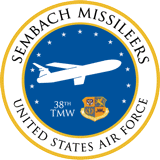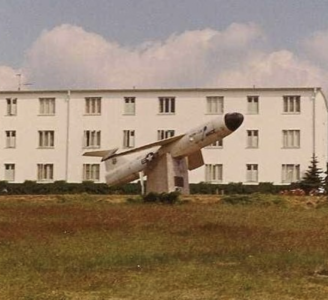The “Missile on a Stick” ©
– Fred Horky, Sembach 1959-1962 –

In my never-ending reverie of all the great times from long ago and far away, all around the world; I’ve about decided that Sembach was THE best time of my life. (After all, it’s where I met, courted, and married the Love of my Life in the middle of the Berlin Wall Crisis!) Today, those good times might be best symbolized by Sembach’s “Gate Guard”, our “missile on a stick”.
It must be added that for a long time, it wasn’t a Mace OR a Matador, but a combination of the two!
But nothing is forever: no sooner had the 38th TMWg folded its colors, than that missile was GONE!

Those that were there when the first missile was installed on the concrete “plinth” next to the BOQ (Bachelor Officer Quarters) knew it was a Matador. Several pictures in its original configuration are seen below, in a similar pose as the first image. Note the obviously longer, high aspect ratio wings the Matador needed for altitude performance: it had to fly at higher altitudes to maintain radar line-of-sight contact with the radar of its ground-based radar controller and his “miscue” (MSQ) radar.

Above and below: the Gate Guard Matador on its plinth: note the long wings.

The self-contained ATRAN guidance system of the Mace needed no such line-of-sight contact, so its intended flight regime was at low altitude, down in the weeds to better avoid Soviet bloc air defenses, where a shorter wing worked better.
The TM-76A Mace had obviously been developed from the TM-61 Matador. (For quite some time the Mace was actually DESIGNATED as the TM-61B). Thus, the airframe had a near identical design interface (attachment points) between center fuselage and the nose guidance section, allowing an easy switch to make THIS Matador LOOK like a Mace.

The Matador’s LONG wing for the high altitude flight regime had a 28’ 7” span; the MACE’s clipped wing for low altitude a 22’ 11” span. Other obvious external differences included the air exhaust seen on the right side, below the “MGM-13” logo. This Matador feature was not repeated on the Mace.

The picture above shows the same MATADOR missile with my good friend, Simulated Missile Pilot Extraordinaire, bon vivant, and fellow bachelor; Ollie Maier. We chose the night-time photo op pose to show off Ollie’s new Mercedes 190SL.

After the 38th Tactical Missile Wing folded its colors in 1966, the Airplane Air Force again took over Sembach, with 17th Air Force Headquarters moving from Ramstein to Sembach. All signs that missiles had ever been assigned at Sembach quickly vanished. With a higher headquarters (and likely fighter pilot commanding general) installed, my guess is that somebody (likely the personage mentioned) quickly decreed “GET RID OF THAT DAMN MISSILE and put a REAL AIRPLANE on that pole … ……preferably, an F-86 Sabre!” ….despite that Sembach had NEVER been an F-86 base.*
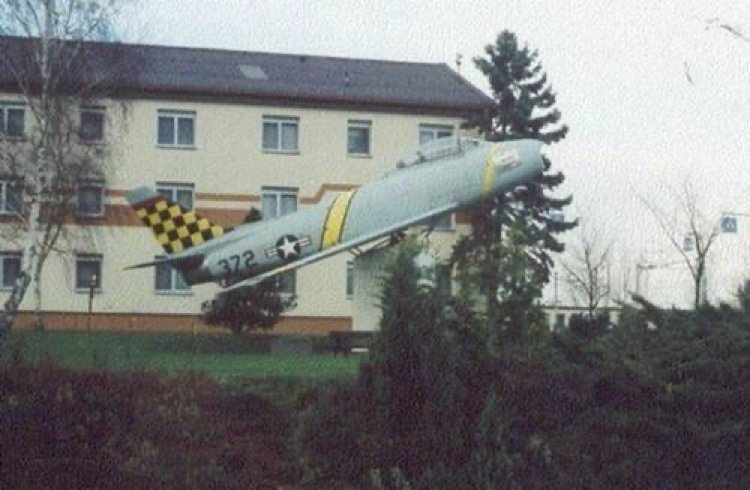
Learned since is that the airplane installed as a suitable substitute for a USAF F-86, was actually a Canadair-built Sabre Mk 6 which had only flown in the Spanish Air Force. One of hundreds originally built in Canada under foreign aid contracts for the Spanish, English, Italian, Norwegian, German, Turk, and the Air Forces of several other countries; the “Mark 6” was noted for its powerful Canadian (Orenda) engine. The type was and still is widely considered to be the “hot rod” of all Sabre variants.
So for years a Sabre-on-a-Stick graced the same, modified plinth that had first held the Matador, and then the Matador/Mace blend. It’s likely that very few newly-arrived troops at Sembach in that era had even known that the base once had missiles as its primary mission. (“Mace? What’s that?”)
Fame is so fleeting!
It’s probably a good bet that this ersatz, never-was-a-REAL-Air-Force F-86 wore the personal markings of some 17th AF commanding general: markings from an earlier time when he had been a young hot shot fighter jock …..just the sort of ego-stroking and apple-polishing expertise that Headquarters Drones are adept at applying. The yellow belly-band and checkerboard fin markings are those of the 51st Fighter Wing of Korean War fame, and which serves at Osan Air Base to this day, now equipped with F-16’s.

(This view of the Sembach Sabre is from the street between the chapel and BX)
Addenda:
After nearly sixty years as a USAF installation, Sembach was turned over to the U.S. Army in 2010 to become “Sembach Kaserne” (https://en.wikipedia.org/wiki/Sembach_Kaserne)
With the Air Force gone and the Army in charge, the F-86 obviously had to go.
Fame is indeed fleeting ……even for the famous F-86 Sabre!
Today the gate guard at that same spot in front of the BOQ is a tank …..
a….. TANK!
As Chester Riley (William Bendix) said eighty years ago in “The Life of Riley” … one of the most famous “catch phrases” of all time …..”What a revoltin’ development THIS is!”
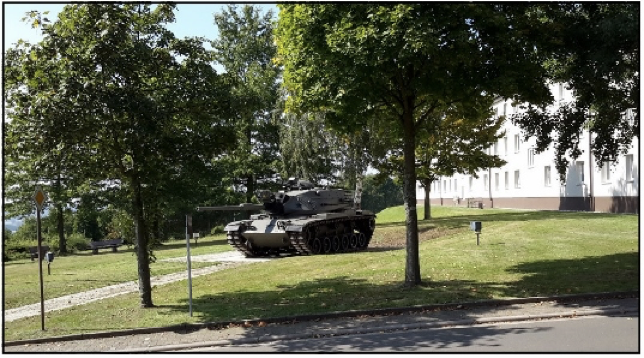
Note: For its entire existence, the Sembach flight line was very unusual by being nearly a mile away from the cantonment area of barracks, offices, housing, etc.. In 1995 the flight line was closed and turned over to the host government for use as an industrial park. It still sort of wraps around the virtually unchanged tiny village of Sembach, at upper right, below.
Today, many of the flight buildings are being used for various light industries, but the runway itself is nearly all gone. At the northeast runway threshold where Ollie and I would cross when landing our T-33 after “simulated missile” training missions for missile radar controllers, there is now the entirely new, hi-tech foundry seen in the photo below. It manufactures parts for the giant wind turbines now seen all over Europe! (See https://heger-gruppe.de/en/innovation/)
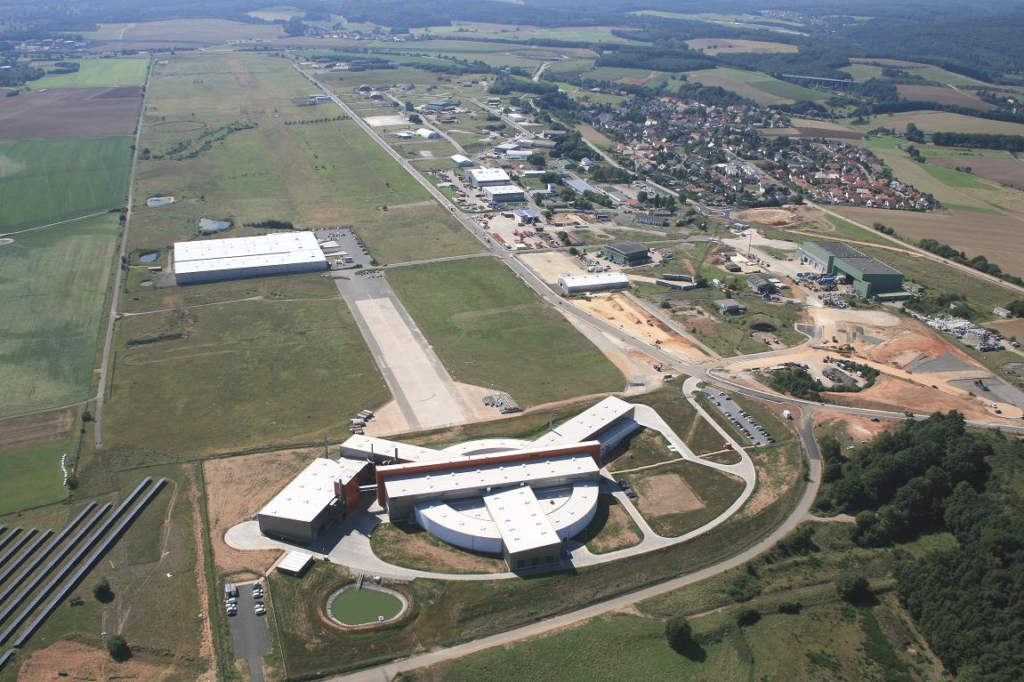
- In about 1961, a Royal Canadian Air Force Mk 6 Sabre from Zweibrucken, CRASHED just to the north east of Sembach; the pilot safely “punching out” (ejecting) when he saw that his “flameout approach” was going to fall short of the runway! (https://en.wikipedia.org/wiki/Zweibrucken_Air_Base)
